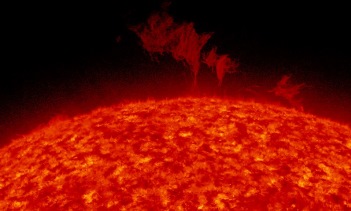
Extreme UV light image of a mass of plasma on the sun. Credit: Solar Dynamics Observatory, NASA
Scientists use high-intensity lasers to generate shock waves in many applications, from cancer therapies to the long-awaited goal of controlled nuclear fusion. Three theoretical physicists at a British university have proposed a new model for using laser-induced shocks to achieve direct ion heating to solar-like temperatures, on femtosecond time scales (Nature Comms., doi:10.1038/ncomms9905).
The theoretical model, devised by Arthur E. Turrell and his colleagues at Imperial College London, shows that collisionless electrostatic shocks would directly heat the lighter of two ions already confined at solid density in a target. Usually in laser heating, electrons within the target heat up first and transfer their thermal energy to nearby ions—an indirect process that wastes time, comparatively speaking.
Unlike planar plasma shocks, the most common shock wave in plasma physics, collisionless electrostatic shocks have a moving electric field. When hitting a target composed of a single ion species, these shocks dissipate their energy mainly through ion acceleration rather than heating.
When two ion species of different masses are placed in the target and subjected to this type of shock, however, the researchers' computer simulations revealed that the electric field accelerates the ions differently, causing heating via dynamical friction between them. The temperature reaches “on the order of keV” (greater than 108 K) in a few tens of femtoseconds. The volume of the target that actually heats up is relatively small, which the team admits may limit its usefulness.
For their simulations, the Imperial scientists used a method well known in plasma physics: particle-in-cell, which tracks individual particles in continuous phase space. The computer model is awaiting experimental verification. Turrell says that he and his colleagues were thinking of the Astra-Gemini high-power infrared laser system at the Rutherford Appleton Laboratory (U.K.) when they wrote their journal article, but other systems, such as the Texas Petawatt Laser at the University of Texas at Austin, may also be capable of testing out the proposed method.
Turrell adds: “The main barrier to doing this as an experiment is probably deciding what diagnostics to use to get an accurate temperature from inside the centre of a target.”
